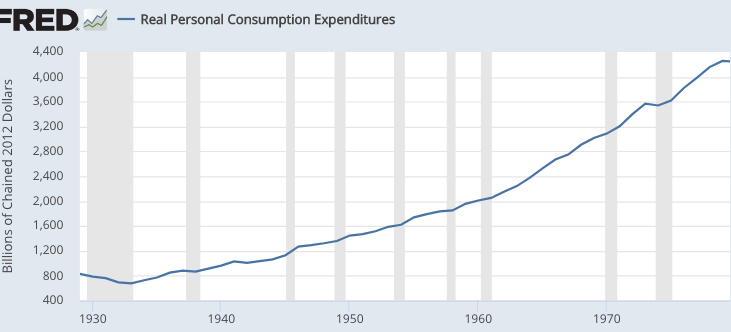
Robert Barro argues that GDP is mismeasured:
That is, the standard concepts of national income and net product count net investment once when it occurs and include the same present value again when adding up the future returns realized on this investment. Therefore, in the steady state, national income involves precisely double-counting of net investment.
Thus suppose Tesla builds a battery factory that costs $1 billion, which lasts for 20 years. They hire workers and pay another $2 billion in wages over 20 years. The batteries sell for a total of $3.3 billion, a profit margin of 10%. In this example, $4.3 billion is added to GDP over the life of the factory—$1 investment and another $3.3 billion in consumer goods (batteries). But there is actually only $3.3 billion worth of actual “goods” being produced; the $1 billion factory investment is an input.
A commenter at Tyler Cowen’s blog suggests that GDP is not mismeasured, rather it is occasionally misinterpreted:
The algebra is fine as it is, but I take strong issue with the idea that GDP “mismeasures” something. As any decent intro macro course will tells its students, “GDP is not a measure of welfare.” Indeed, the Kuznets quotes that Barro points to are exactly of this nature; we have this high profile GDP number, but it doesn’t do what you want it to do – or at least not ALL the things you want it to.
What Barro does here is construct a new measure – present discounted value of consumption – and shown how it relates to GDP (and GDP’s present discounted value). In addition, he provides a capital income / labor income decomposition for both measures (GDP having such an exact decomposition because of constant returns to scale, Euler’s identity for homogenous functions, and marginal-value input prices). He then says present discounted value of consumption, and its associated decompositions, are “right” while the other the construction GDP is “wrong” and thus gives “misstated” decompositions. Of course, “right/wrong” and “correct/incorrect” begs the question – right about WHAT? Correct for WHAT?
Let’s look at an example:

Real consumption expenditures fell by 2.37% in 1942, and rose by nearly the same percentage in 1970. Yet 1970 was a recession year while 1942 was a boom year. Why is that? In 1942, military spending rose sharply and unemployment was very low despite falling consumption. In 1970, investment spending declined and unemployment rose sharply, despite healthy consumption.
If you are interested in studying labor markets over the business cycle, then real GDP is probably the number you should focus on. Total production impacts the labor market. (In that sense I agree with Tyler’s commenter). If you are interested in most other topics, including living standards, tax incidence, and economic inequality, then consumption is the right variable. Unfortunately, we tend to use GDP (or national income) for all sorts of issues where it doesn’t fit. We inappropriately tax income when we should be taxing consumption. We study income inequality when it is consumption inequality that matters. We compare living standards across countries by looking at GDP/person, not consumption/person.
In the Tesla example, a consumption tax applies to the $3.3 billion in batteries, whereas an income tax applies to the entire $4.3 billion in GDP–double taxing the $1 billion investment.

Is Barro’s paper important? I’m no expert in this area, but the following seems rather important, given the way most people interpret income share data:
That is, the combined 1999 and 2013 revisions in the BEA’s measurement of intellectual property can “explain” a rise in the capital-income share of GDP from 0.33 to 0.40.
Barro is saying that an entirely arbitrary definitional change by federal bureaucrats made the capital-income share seem to rise substantially. This reminds me of an earlier Matt Rognlie paper, which showed how the capital-income ratio is affected by imputed income from houses.
The more we learn about these issues, the clearer it becomes that the real issue is not the share of income earned by capital, rather it is the increasing inequality of labor income. Progressives should advocate a progressive wage tax, where investments are expensed and all “capital income” earned by workers (including CEOs) at their own firm is treated as wage income. This would help to reduce tax avoidance schemes.

READER COMMENTS
Benjamin Cole
Jul 27 2019 at 8:42pm
The NBER has produced long papers, full of graphs and calculus, that labor income as a share total income has been declining, even after adjustments for capital depreciation. This seems to be happening globally. But I have to agree with Scott Sumner that clarity in this issue is impossible.
The taxing of income, whether domestically or internationally, whether on persons or corporations, has become a shell game Gong Show. If you are paying income taxes, then you are a chump.
Though it is unlikely to happen, and thus hardly worth the effort to even discuss, moving to a system of property taxes and away from a system of income taxes is probably best. Add on some national sales taxes, heavy fuels taxes, and yes I say tariffs.
Progressives and conservatives would do well to ponder the proceeding.
Thaomas
Jul 28 2019 at 6:40am
Why a progressive wage tax and not a progressive consumption tax? Don’t we want people to invest their capital income not consume it?
Jon Murphy
Jul 28 2019 at 7:58am
Dangerous thinking for two reasons:
1) “We” shouldn’t want anything about what other people do with their money.
2) People will consume or save/invest depending on the interest rate and their options. Interest rate is just a price. Thus, it’ll give signals and that people will interpret. When interest rates are relatively high, a person will tend to save more and consume less. When interest rates are relatively low, people will tend to consume more and invest less.
Alan Goldhammer
Jul 28 2019 at 8:34am
I don’t think this is correct in terms of linking consumption (but I’m not an economist and my be totally wrong). As Allan Sloan pointed out in today’s Washington Post, a lot of investment decisions are tied to interest rates. With abnormally low rates, more people are being forced into equity investments in order to achieve a decent rate of return. This situation is more dire in countries where negative rates are present (Sloan uses Germany as an example). The impact on the Social Security Trust Fund is also remarkable.
Jon Murphy
Jul 29 2019 at 2:42pm
I don’t think I understand your comment, Alan. Can you rephrase it, please?
Scott Sumner
Jul 28 2019 at 10:49am
A wage tax and a consumption tax are identical in the long run.
Mark Brady
Jul 29 2019 at 4:47pm
But not if there is permanent saving.
Thaomas
Jul 30 2019 at 10:11am
It is possible to construct a model in which a proportional wage tax and a proportional consumption tax are identical. I doubt if that model would give the same results from a progressive wage and progressive consumption tax with initial conditions of today’s economy. I think it would be easier to construct a progressive consumption tax that meets MY idea of the proper trade off between growth and redistribution than a progressive wage tax. Your mileage may differ.
nobody.really
Jul 29 2019 at 2:58pm
See David Bradford’s X Tax, a progressive consumption tax.
Benoit Essiambre
Jul 28 2019 at 12:22pm
I’m no expert but it seems to me that this $4.3 billion is not double counting if you’ve produced $3.3 billions in product and, this is the important part, are left with a factory still worth $1 billion at the end.
If the factory is spent and you need to build a new one to continue producing, then yes it would be double counting.
My guess is that there are provisions to take into account the worth of the factory and depreciation when calculating GDP but, again, I’m no expert.
Scott Sumner
Jul 29 2019 at 4:30pm
Benoit, The only value of a factory is the final output it produces. It’s possible that the factory could later be converted to another use, and then the consumption produced by that other use would need to be accounted for. I tried to make my example simple with a 20 year lifespan, to get at the essential issue.
Mark Brady
Jul 29 2019 at 4:50pm
Depreciation, which includes obsolescence, is deducted from GDP to calculate Net Domestic Product (NDP).
Matthias Görgens
Jul 28 2019 at 11:55pm
Just tax land values first, and then see whether you still need other taxes.
You could probably finance a Singapore style size of government on land tax alone.
Todd Kreider
Jul 30 2019 at 12:06pm
But looking at GDP per person does work fairly well when comparing standards of living when using Purchasing Power Parity (PPP) , which for some reason Scott and Bryan don’t use.
Scott Sumner
Jul 30 2019 at 3:43pm
Todd, Actually, I do frequently use PPP adjusted GDP. But it remains true that (PPP adjusted) consumption better measures living standards.
Todd Kreider
Jul 31 2019 at 7:06pm
Scott, from a comparative stand point they should be about the same. By the way, Penn Table 9.1 gives real consumption in $2011 but where do you find PPP adjusted consumption? If you compare Japan and France which are at $44,000 and $43,000 respectively, what are those countries’ PPP adjusted consumption per capita? Thanks.
Comments are closed.